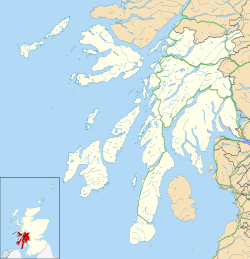This article needs additional citations for verification .(June 2022) |
Knockan
| |
|---|---|
 Coastal scene, looking towards Loch Scridain | |
Location within Argyll and Bute | |
| OS grid reference | NM4023 |
| Council area | |
| Lieutenancy area | |
| Country | Scotland |
| Sovereign state | United Kingdom |
| Post town | ISLE OF MULL |
| Postcode district | PA67 |
| Police | Scotland |
| Fire | Scottish |
| Ambulance | Scottish |
| UK Parliament | |
| Scottish Parliament | |

Knockan (Scottish Gaelic : An Cnocan) is a township of six crofts in the community of Ardtun, in the south of the Isle of Mull off the west coast of Scotland.
Cnocan in Gaelic means "little hill". The cottage called "Knockan" is distinguished by its bright red roof and white walls, set by a small hill. It is around 200 years old and was originally built by a weaver of the local crofting community. It is now owned by his descendants, the family of Donald Black. The other crofting cottages in the "township" of Knockan include "Knockan House" and "Rhudda na Cruban"
Knockan is situated on an unclassified road, north of its junction with the A849. [1] The A849 is the main route across southern Mull, travelling from Salen to Fionnphort, via Craignure. [2]

